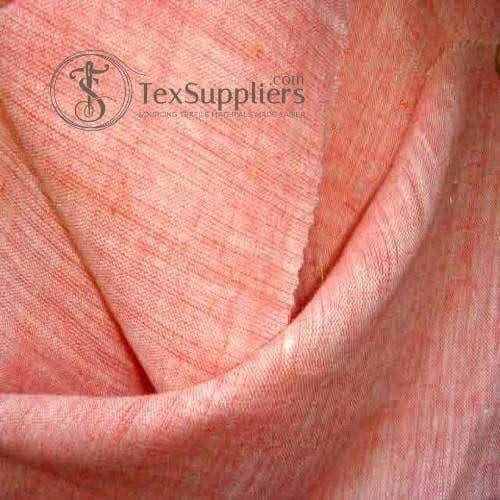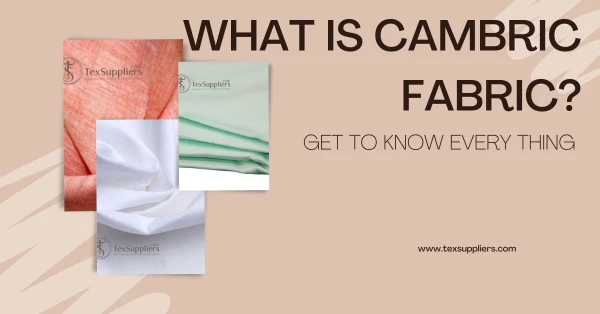Cambric is a particular type of French fabric that has been used for a long time. To begin with, it's a woven cotton fabric that's not overly heavy. It is distinguished from cotton and linen because it is woven with a short and twisted thread. These fibers have not been going through bleaching; hence, they are in their normal situation. The weaving contributes to the fabric's overall polished and modern appearance. Thus, Cambric is perfect for all types of embroidery and needlework and helps create various clothes.
Table Of Contents
What is Cambric Fabric?
Cambric fabric is cotton made fine, lightweight, and plain tightly woven fabric often in a greige color with a smooth and silky appearance. Its yarn count usually ranges between the 60s - 80s. Usually, it goes through a process called calendering that makes it tighter, stiff, and glossy. Cambric fabric can hold its shape, glossiness, and stiffness for years. It's an ideal choice for embroidery and lacework.

In the past, the fabric known was called Cambric, made by weaving together either flax or linen. During the early part of the 1900s, manufacturers were responsible for its production. Cambric can be used for a wide variety of projects, including embroidery and lacework, in addition to garment creation. Cambric is sometimes called "batiste" when it is used for other types of handicrafts.
Early History
Cambrai, a city in southeastern France, is credited with being the birthplace of cambric cloth. It is believed that a local weaver named Jean Baptiste Chambray came up with cambric cloth in 1300. Beautiful linen was the inspiration for the first cambric fabric.
The Flemish term "kameryk" originates from the English word "cambric." Its French equivalent, "batiste," has been used since 1590, while the English word "cambric" has been used since approximately 1530. White linen cloth was the original name for both Cambric and batiste. There is historical evidence of a silk cambric fabric.

Cotton has surpassed other fibers to become the most popular choice for Cambric. In fashion-forward towns like London in the late 1500s, printed Cambric was widely available in various styles and patterns. Many other types of home decor. For example, dresses, wall hangings, and curtains are made from cambric materials and clothing. Cambric was commonly used for lace and embroidery in this period.
Over time, different American and Egyptian cotton types have been used to manufacture cambric cloth. Thread counts for Cambric yarns would be anything from 60 to 80. Then, the linen or fine cotton was treated to make it shiny.
Eventually, when other and better materials entered the market, Cambric's appeal waned. In contrast to the time-honored methods used to create cambric fabric, the contemporary techniques used to develop competing textiles pose a severe threat to its market dominance. Popular even now, chambray is a kind of Cambric that has many uses. There are still certain places where you may get high-quality cambric materials.
Every Cambric is Cambray Fabric but Every Cambray is not Cambric Fabric
What is Cambric Fabric Made Of?
American or Egyptian cotton is used to make contemporary cambric fabric. It's made up of 60-80-count warp and weft (filler) yarns and is calendared to give one side a subtle sheen.
Some or all of the Cambric in the garment may have been bleached or dyed. It's not too heavy, has the right amount of body for stitching, and is the right size. Cambric is perfect for handkerchiefs, children's outfits, slips, undergarments, and nightgowns since it washes and dries so quickly.
Manufacturing Process
The raw material used to produce cambric affects the production process. In recent times, linen and silk Cambric are rarely applied to manufacture this type of textile. We'll discuss how cotton yarn is made from chambray's primary material.
Extracting the seed's fibers produces cotton. Cotton plants have roots wrapped in white fiber picked with a cotton gin. Sometimes cotton seeds are hand-gathered. After removing the seeds from the fibers, they are baled and crushed. After that, carding converts mixed cotton into rope-like strands.
In the next step, the yarn for weaving into Cambric. Egyptian, Pima, and Supima cotton have longer fibers, resulting in softer and more durable apparel. Most cambric is made using short-staple cotton. On the other hand, long-staple cotton produces higher-quality fabric.
Cotton yarn is woven into cambric, a type of cloth, differently from denim, despite their similarities. "Warp" and "weft" are the two yarn strands used to weave cloth. How these two strands are woven together determines the fabric's character. Denim weft threads are white or lighter than warp threads. Not always. This will result in a cloth lighter than the warp thread. Using a dark warp thread will result in a softer cloth.

Properties
|
Fabric name |
Cambric |
|
Alternative Name |
Batiste |
|
Moisture-wicking ability |
High |
|
Composition |
Cotton |
|
Heat retention ability |
Medium |
|
Thread count variations |
150-500 |
|
Fabric breathability |
Very breathable |
|
Prone to pilling/bubbling |
Low |
|
Stretchability (give) |
Low |
Properties
Characteristics
Cambric fabric has many distinct characteristics that make it preferable for the intended use, including.
- Breathable: This fabric's partitioned fibers allow air to flow freely through the material. As a result, Cambric is a breathable fabric that is quite comfortable to wear.
- Lightweight: Cambric is traditionally made from cotton; thus, it is thin and easy to wear.
- Tight and Twisted Weaving: Cambric is made with the weaving mentioned above methods. This allows designers to add elaborate needlework to the cloth with relative ease.
- Easy to Dye: Because it is so easy to dye, Cambric is the most incredible fabric.
Applications
Cambric fabric has many different applications as follows:
- Handkerchiefs
- Underwear
- Children's dresses
- Nightgowns
- Slips
FAQ
What kind of fabric is Cambric?
An incredibly lite in weight, tightly woven cotton cloth is called cambric fabric.
Can I use cambric fabric in summer?
Since the fabric is airy and lite, you can comfortably use it in summer.
Does cotton cambric wrinkle?
Shirts made from wool are not too wrinkled like those made from linen or a cotton/linen combination due to the inherent properties of each fabric. Wrinkle resistance is high with intrinsic durability, just like nylon and spandex for the fibers made by chemical synthesis.
Conclusion
Cambric is a shiny, rigid fabric that is both soft and lite. Cambria is the birthplace of this fabric. Dresses, men's shirts, outfits, lacework, embroideries, and various other textile arts use cambric cloth in different forms. Cambric cloth is of a higher grade. And we can use it in needlework, embroidery, and other forms of artistic expression.






.webp)





Comments - 00
Leave A Reply
Thanks for choosing to leave a comment.